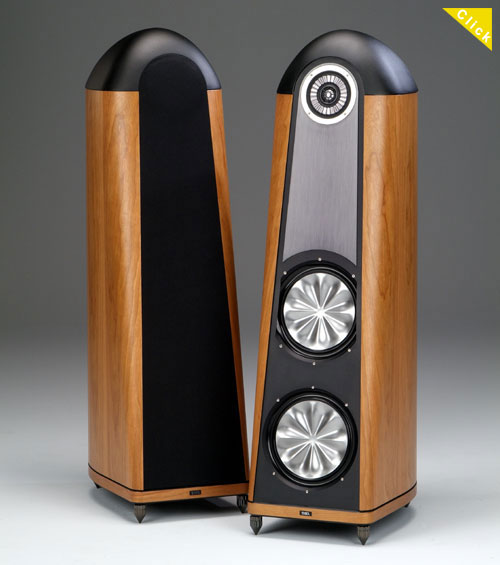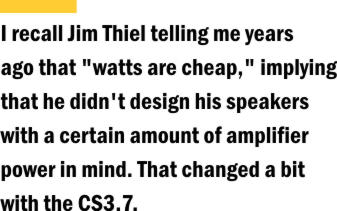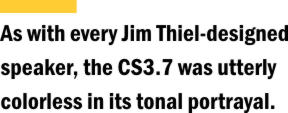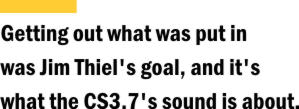Thiel Audio • CS3.7 Loudspeakers
t seems wholly inadequate to call Jim Thiel (1947-2009) a "speaker designer." For more than three decades, he performed high-level research on every aspect of loudspeaker creation, refining his personal approach along the way. "Acoustic scientist" more accurately describes his role, not only in terms of the company he co-founded and that bears his name but in the audio industry at large. One of my most enduring memories of him, and of my time in the audio press, came in 1999, as I listened to him while he picked through a large box of speaker cones he kept in his office. He would choose one and immediately tell me everything pertinent about its material and shape, explaining the properties that made it suitable -- or not -- for one of his speakers. That was Jim -- encyclopedic in his knowledge yet constantly trying to make new discoveries that would enable him to produce better speakers.
Even though the CS3.7 took a greater-than-anticipated amount of time to go from drawing board to dealer showroom, Jim did get to oversee it throughout the process. It incorporates many of his "new discoveries," all of which culminate in a speaker that's truly inspired. The CS3.7 is a three-way speaker that features a characteristic Jim Thiel-designed driver complement: a coincident tweeter/midrange, a robust aluminum-cone woofer, and a passive radiator. The coincident driver places the tweeter in the center of the midrange to ensure time coherence for every listening position. Among this driver's innovations is a midrange diaphragm made of aluminum that's pressed into a corrugated shape, which increases its stiffness, pushing its resonance frequency beyond the limits of human hearing. The diaphragm is essentially flat in order to create virtually no diffraction effects for the tweeter mounted in the center of it. The tweeter also uses an aluminum diaphragm along with Thiel's well-known long-gap motor system, whose flux is increased enormously by a set of one axial and four radial neodymium magnets. There is literally no other driver in the world like this one, and no other speaker in the Thiel line that uses it. The CS3.7's woofer is a classic Jim Thiel driver designed to deliver prodigious low frequencies at vanishingly low distortion. It also uses an aluminum cone that's essentially flat to decrease diffraction caused by the typical conical cavity of a large bass driver. Among the woofer's many features are a copper pole ring and pole sleeve, which respectively stabilize the driver's flux and reduce inductance nonlinearity in the voice coil. Instead of a port, the CS3.7 -- and indeed most Thiel speakers -- has a passive radiator, whose diaphragm is identical to that for the woofer. This avoids noise issues from the port and also gives Thiel speakers their characteristic bass speed and impact. Also characteristic of Thiel speakers is a first-order crossover. While this is, in Jim Thiel's words, "the only type of crossover that provides complete accuracy of amplitude, phase time and energy, and therefore the only type that does not distort the musical waveform," its 6dB/octave slopes require more of the drivers, which have to handle uncommon amounts of power above and/or below their crossover points. Power handling isn't an issue for most well-designed woofers, but it is for a tweeter and midrange, and it helps explain the designed-in robustness of Thiel drivers. Each driver is measured prior to use, and they are not installed in speakers in pairs, which is nearly always the case across the industry. Instead, each driver is measured against a reference, and it either meets the strict tolerances required or it doesn't, in which case it's rejected. Thus, Thiel drivers are matched -- each to the reference, not to another driver. The CS3.7's cabinet is as important to the speaker's sonic output as the drivers or crossover. Thiel speakers have always featured stout cabinets, often crafted from multiple layers of MDF and sometimes cement-like composite materials. The CS3.7's cabinet goes in a different direction, making use of multiple materials chosen for sonic and practical reasons. The contoured side panels are made of 15 plies of birch, masonite and paper, which are steamed to make them pliable. They are then glued and pressed into a mold. Moisture is removed during a heat-curing process, with the finished panels comprising 70 percent wood material and 30 percent adhesive. The back and internal braces are machined from MDF, while the front baffle is a sculpted slab of T6061 aluminum. The rounded top is a die-cast metal cap whose shape makes for the perfect internal cavity for the coincident driver. The crossover is mounted on a hatch that fits tightly into the speaker's MDF bottom plate. All of those pieces may seem easier to combine than they actually are. I visited Thiel last fall and saw how the CS3.7 is made. This not only gave me a much greater appreciation for the craftsmanship required but also emphasized just how much thought has gone into this speaker. I could literally spend several thousand words divulging and explaining all of the design and manufacturing fine points of the CS3.7, and I'd still not discuss everything. Such is the intricacy of Jim Thiel's work. Dressing for success wners and other audio writers may have had an easy time setting up Thiel speakers, but I haven't. Perhaps due to the speakers' acute time and phase correctness, or perhaps due to some quirk in my hearing, positioning a pair of Thiel speakers has always required abundant forethought and experimentation. I've set up (or had set up for me) many speakers in my current room, so I know the best general spots for them, and these proved best for the CS3.7s as well. But there were other important considerations, including the speakers' relationship to the listener. From my experience, you need to sit far enough away from a pair of Thiel speakers to allow the drivers to integrate, but only a little farther away than the speakers are apart from each other. The distance to the listening seat also affects proper toe-in for the speakers, which is ultimately a judgment call. I spent part of three days moving and listening, listening and moving, in order to reach a point of satisfaction, so patience, more than an understanding of acoustics, may be the best skill to possess when setting up the CS3.7s. In my room, I ultimately had to move my listening seat back more than a foot. This put it 10' 8" from the front of the speakers, which were 10' 2" apart. This not only helped achieve the best (to my ears) top-to-bottom balance but also a very wide, very deep arcing soundstage. I greatly prefer this to one that simply stretches in a line from speaker to speaker, which is what I had early on. Placing the speakers so they're firing straight ahead, playing some music you know well and then rotating them toward the listening position will help achieve the optimum spectral balance. The goal is for speakers to demonstrate neither too much treble nor too little bass and avoid a midrange suckout. Straight ahead may, in fact, be their best position, depending on the distance between the speakers and the listening position. In my room, toe-in was very slight, the output of the speakers crossing somewhere far behind the listening seat. The grille is considered a necessary part and it improves the speaker's looks, so there's no reason to take it off.
As with any speaker, after the power threshold has been reached, the choice of amp to use with the CS3.7s will be a matter of what you hope to achieve sonically. However, the CS3.7s are especially chameleon-like, revealing not just what different amps can achieve when used with them, but how some amps skew the outcome. You will hear the sonic truth of your electronics with the CS3.7s, and that may not represent all good news. For this reason, the CS3.7s are a better place to begin assembling a system than to end, carefully choosing amps and sources to use with them instead of pairing them with your existing electronics and hoping for a polished result. More than most speakers, I suspect, the CS3.7s will lead owners to re-examine the rest of their systems. Then and now had talked to the people at Thiel about reviewing the CS3.7s even before the speakers were on the market. However, it took until now -- a few years and several reviews after the CS3.7's introduction -- for the drivers to align and a pair of the speakers to make it to my doorstep. Throughout this time, I had heard the CS3.7s several times at shows, and I also heard them last year in Thiel's impressive, purpose-built listening/conference room. At past CESes and Rocky Mountain Audio Fests, the CS3.7s sounded fast, somewhat lean and exceedingly clear, often exposing issues with recordings in an unforgiving way. They had never generated much bass, although the low frequencies were always quick-paced and nimble. At Thiel, however, the speakers came into fragrant full bloom, driven by a pair of Krell mono amps. The clarity and quickness were still apparent, but so was impressive bass depth and heft. Thiel had positioned one of its SmartSub subwoofers between the speakers, and I was sure it was part of the system. But it wasn't -- the deep, billowy bass I was hearing came from the CS3.7s alone. I'm not sure what to chalk up this deviation to. I subscribe to Paul Bolin's axiom regarding show sound: If it's good, the products making it are worth investigating. If it's bad, I know no more about those products than if I had never heard them.
However, as you might be able to guess, such thrills can come at a price: a relentless nature that can make lesser recordings sound unpleasant, even downright unbearable. The CS3.6es, which I owned years ago, could be this way without ample care in setup and careful attention to ancillary equipment. And even with all that, the outcome would still be brutally revealing of deficiencies, at least as the speakers were configured in the small listening space I had at the time. The CS3.7s resolve just as much recorded detail -- astonishing amounts -- as the CS3.6es, but at the same time they are more forgiving of sonic missteps. I suspect that frequency-response plots of both speakers would provide little or no explanation as to why this difference exists, proving once again that our ears are more perceptive than any test equipment -- and that Jim Thiel's design approach had evolved over time. With the CS3.7s, nothing on any recording remained uncovered, including its spatial fingerprint: pinched toward the center, spread out laterally but with little depth, curving behind each speaker before meeting in the middle, or something else entirely. The ear-bending spatial effects on Los Lobos' Kiko [Slash/Warner Bros. 2-26786] were otherworldly -- with guitars floating outside the speaker positions. These can be so unnerving that I will often run a test when I hear them, just to be sure of what I think I'm hearing: I close my eyes and point to the place in the soundfield from which the sound in question is coming. I open my eyes and often discover that I'm pointing to a spot a few feet outside the speaker. This happened with the CS3.7s, such was their ability reveal this information. The midband was the source of much of the CS3.7's overall character. The midrange-driver's response is flat to 20kHz, where only tweeters dare tread, and while Thiel isn't making full use of all that energy, the driver is able to handle the demands of the first-order crossover, sounding unfettered tonally, spatially and dynamically throughout its range. The speaker's midrange is fundamentally lighter and leaner than that of competing products, but voices as diverse as Diana Krall's and Greg Brown's were well characterized and as distinct as I've heard them. I've been listening to the James Taylor LP Dad Loves His Work [Columbia TC 37009] since I was in high school. The entire recording is on the warm side of neutral, though Taylor's and J.D. Souther's voices on the semi-hit "Her Town Too" were always well delineated, even as they sing in unison. The CS3.7s lightened up the recording and defined the voices beyond my recollections, which come from hearing the LP on many speakers over the years. "Her Town Too" also raised a question that I asked myself several times while listening to the CS3.7s: was this more or less real? There was no question that there was less tonal adornment, but at the same time the physical sense of the singers as well as the massed power of the backing band were diminished. Or were they embellished with other speakers? One of Jim Thiel's professed aims was to create speakers that accurately translate the input signal into sonic output. However, we listen to what comes out of the speakers, not what goes into them. While I cannot speculate on the accuracy of the input signal, I can say that the CS3.7s reproduced this music in a way that other speakers did not. The bass of the CS3.7s raised the same question, and one more: why couldn't I achieve the same heft and power as Thiel did in its listening room? On the one hand, the bass was more prominent -- realistically so -- in my room than I had heard at any show. The speakers seemed to go lower and offer a better sense of bloom, the acoustic bass on the Wood Brothers' Ways Not to Lose CD [Blue Note 43120] spreading like water throughout my room. On the other hand, there wasn't the same punch, drive and slam, nor quite the same sense of weight, as I heard at Thiel, which ably demonstrated the quality and quantity of the CS3.7's bass. In my room, on material with really low frequencies, like Harry Connick's She [Columbia 64376], the CS3.7s were more heard than felt. At Thiel, the same frequencies were heard and felt. Canada's top contender here are some striking similarities between Thiel Audio and Canadian speaker giant Paradigm, whose Signature S8 v3 floorstanders left my listening room a few weeks before the CS3.7s arrived. Both companies design their speakers according to well-defined principles. For Paradigm, this means speakers that achieve wide dispersion, low distortion, low coloration and wide bandwidth. Both companies believe that the process begins with the drivers, which each company designs and manufactures. Thiel has its coincident midrange/tweeter, and Paradigm its P-Be tweeter, with a pure-beryllium dome, and Co-PAL midrange, which has a cobalt-infused pure-aluminum cone. Both brands have major elements manufactured in China -- some of Thiel's drivers versus Paradigm's cabinets. The CS3.7 and Signature S8 v3 are roughly the same size, and their grilles are considered integral parts, not just cosmetic niceties. The Signature S8 v3s cost $7998 per pair in cherry finish and $8798 in gloss-black or maple, so there's a nearly $5000 difference in price between them and the CS3.7s. Still, for floorstanding speakers of this pedigree, both the CS3.7 and Signature S8 v3 are comfortably within the price range of their competition. There is, in fact, precious little competition for the CS3.7 and Signature S8 v3 from speakers of similar price. Paradigm's beryllium-dome tweeter is truly special, combining airiness, body and delineation, along with the inherent quickness to launch transients into the listening space. Like the CS3.7s, the Signature S8 v3s revealed copious amounts of musical detail, including the sense of space captured on each recording, but the low bass had slightly greater heft. They also had a sweeter, more easeful portrayal, while the CS3.7s were tonally lighter, more grippingly visceral, and quicker into and out of each note, especially in the bass. The Wood Brothers CD made for a useful comparison, the Thiel speakers emphasizing transient speed, spaciousness and overall clarity, and the Paradigm speakers sounding fast and silky in the treble, physical in the midrange, and bloomy in the bass. The rated 92dB sensitivity of the Paradigm speakers made them more amplifier friendly, but, like the CS3.7s, they sounded their best when the Lamm M1.2s or Ayre MX-Rs were providing the power. The differences in the amps were always apparent. These two prominent, well-engineered speakers came at the music from different points of strength. They underscored the ample divergence across high-end audio, even among speakers with similar design premises and goals. End notes here is a video interview on the Thiel Audio website in which Jim Thiel discusses the engineering responsible for the CS3.7. You can read about essentially everything Jim discusses, but watching the video is far more instructional. It is clear from the interview that while divulging the fine points of his final project, Jim was thoroughly in his element, generously explaining how his thinking led to the speaker he's sitting near. The video was shot before Jim's illness had significantly reduced his physical and mental vigor. His voice was strong and his presentation sharp. Jim was someone whose intellect never overshadowed his inherent graciousness, which was as much on display in the video as in the CS3.7.
As I watched the interview with Jim, I had one enduring
thought: we would all be fortunate to have as revealing and elegant a symbol of our life's
work as the CS3.7.
|


 Amplifiers are an important
in-use consideration for a pair of Thiel speakers. I recall Jim Thiel telling me years ago
that "watts are cheap," implying that he didn't design his speakers with a
certain amount of amplifier power in mind. That changed a bit with the CS3.7. While it has
a rated 90dB sensitivity, Thiel still suggests 100-600Wpc for it, and I'd say this is a
good rule of thumb if the 100 watts come from stout amps like Lamm M1.2s, which were a
terrific sonic match with the CS3.7, offering weighty, powerful low frequencies and a
touch of midrange ripeness. Just as good, though in different ways (quieter, a better
rendering of space), was a pair of Ayre MX-R monoblocks, which have roughly three times
the power of the Lamm amps. In terms of tubes, an Audio Research Reference 110 drove the
speakers well and offered a lovely, liquid midrange.
Amplifiers are an important
in-use consideration for a pair of Thiel speakers. I recall Jim Thiel telling me years ago
that "watts are cheap," implying that he didn't design his speakers with a
certain amount of amplifier power in mind. That changed a bit with the CS3.7. While it has
a rated 90dB sensitivity, Thiel still suggests 100-600Wpc for it, and I'd say this is a
good rule of thumb if the 100 watts come from stout amps like Lamm M1.2s, which were a
terrific sonic match with the CS3.7, offering weighty, powerful low frequencies and a
touch of midrange ripeness. Just as good, though in different ways (quieter, a better
rendering of space), was a pair of Ayre MX-R monoblocks, which have roughly three times
the power of the Lamm amps. In terms of tubes, an Audio Research Reference 110 drove the
speakers well and offered a lovely, liquid midrange. Once properly set up in my
room, the CS3.7s sounded like an amalgam of the speakers I had heard at shows and in
Thiel's room. As with every Jim Thiel-designed speaker, the CS3.7 was utterly colorless in
its tonal portrayal. This gave a frank representation of each voice or instrument, while
at the same time making the differences between music formats and the equipment itself
seem more varied. Top-notch recordings like the Music Matters 45rpm Blue Note reissues
were tonally realistic, with a gem like Eric Dolphy's Out to Lunch [Blue Note/Music
Matters MMBST-84163] launching from the speakers without a bit of added sweetness or
gloss. The RVG CD [Blue Note 4163] sounded gray and grungy by comparison, with a
leading-edge sharpness that seemed exaggerated. When I reviewed the Ayre MX-R amps, I
talked at length about their transient fidelity -- their ability to portray not just the
speed and snap of a drum strike, but its decay to the very noise floor. Much of my
understanding of this came from using the amps with the CS3.7s, which, no matter the amp,
always sounded simultaneously like themselves and like the equipment in front of them in
ways that could make listening to the best recordings absolutely thrilling.
Once properly set up in my
room, the CS3.7s sounded like an amalgam of the speakers I had heard at shows and in
Thiel's room. As with every Jim Thiel-designed speaker, the CS3.7 was utterly colorless in
its tonal portrayal. This gave a frank representation of each voice or instrument, while
at the same time making the differences between music formats and the equipment itself
seem more varied. Top-notch recordings like the Music Matters 45rpm Blue Note reissues
were tonally realistic, with a gem like Eric Dolphy's Out to Lunch [Blue Note/Music
Matters MMBST-84163] launching from the speakers without a bit of added sweetness or
gloss. The RVG CD [Blue Note 4163] sounded gray and grungy by comparison, with a
leading-edge sharpness that seemed exaggerated. When I reviewed the Ayre MX-R amps, I
talked at length about their transient fidelity -- their ability to portray not just the
speed and snap of a drum strike, but its decay to the very noise floor. Much of my
understanding of this came from using the amps with the CS3.7s, which, no matter the amp,
always sounded simultaneously like themselves and like the equipment in front of them in
ways that could make listening to the best recordings absolutely thrilling. It's impossible to listen
to Jim discuss the drivers, cabinet and crossover he designed and not be impressed with
his command of the subject. Not coincidentally, the same holds true for the CS3.7. It is a
speaker that successfully achieves its design goals. Overall clarity, tonal neutrality and
retrieval of musical detail are the overwhelming characteristics of its sound; it acts as
a conduit for the equipment in front of it and the music played through it, exposing the
essence of it all. Getting out what was put in was Jim Thiel's goal, and it's what the
CS3.7's sound is about.
It's impossible to listen
to Jim discuss the drivers, cabinet and crossover he designed and not be impressed with
his command of the subject. Not coincidentally, the same holds true for the CS3.7. It is a
speaker that successfully achieves its design goals. Overall clarity, tonal neutrality and
retrieval of musical detail are the overwhelming characteristics of its sound; it acts as
a conduit for the equipment in front of it and the music played through it, exposing the
essence of it all. Getting out what was put in was Jim Thiel's goal, and it's what the
CS3.7's sound is about.